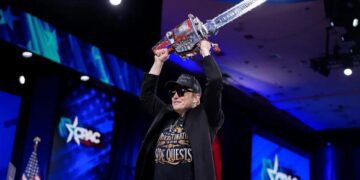By John F. Di Leo, Opinion Contributor
Log onto Facebook. Before you know it, you’ll see ads from Temu or Wish, pitching cheap products.
Or open your old email account, the one that you’ve had for years, so it gets the most spam. Every other message is an offer from some unknown store, selling the sort of thing in which a person like you just might be interested.
Or log onto Amazon and look for something, anything at all. Twenty percent of the hits, maybe more, will be “sponsored” items, often from a brand you’ve never heard of.
Of course, you can shut down the internet, close the laptop, and drive to your local retailer, where the shelves are full of name brand items, bearing logos you’ve known all your life – many of which, maybe most, have one thing in common, regardless of the brand, commodity, or price point:
They are all made in China.
No, not everything. That would be an exaggeration. But most of the durable goods we buy today are either made in China outright, or made somewhere else with a surprisingly high percentage of Chinese materials.
The change has been gradual, but undeniable. Over the past 40 years, Chinese content has taken over an alarming number of industries – not just finished goods, but the components that other countries use in their own finished goods.
A complex manufactured product – such as a pump or refrigerator, car or furnace – that doesn’t depend on a significant number of Chinese components – is rare indeed.
The common assumption – at least, among people who recognize that this is indeed a problem – is that there are three separate things – unrelated things – going on in China.
-First, some legitimate companies that do a good job, making a fine product.
-Secondly, some bottom-feeder companies that take advantage of slave labor and permissive regulations to make low-priced junk for Wish and the dollar stores, and
-Thirdly, some criminal enterprises that steal copyrights, trademarks, and patents, routinely committing intellectual property infringement by making knock-offs.
But the truth is, these are not really particularly separate things at all. All three of these aspects of the Chinese economy are part and parcel of the general Chinese goal to dominate the globe economically. They all work together.
An Honest Effort – but Too Little, Too Late
To understand the business model of modern Mainland (Red) China, we need to appreciate an economic concept known as Dumping.
People generally assume that dumping has something to do with low quality, cheap goods. And it certainly can, but it doesn’t have to. That’s not part of the definition.
Dumping is an effort by one country to unfairly destroy the domestic manufacturing community of another country. The key word is that it’s unfair, a program to use government power (such as subsidies, tax breaks, grants, or other government assistance or permissions) to enable a company to sell goods internationally below cost.
A country “dumps” products by subsidizing, promoting, or otherwise encouraging its companies to export goods at a loss to another country, with the goal of gradually putting the target country’s domestic sources out of business… so that the dumping country can eventually swoop in and dominate the that import country’s market at the actual price.
The kind of dumping that most of us are familiar with is the kind that the International Trade Administration investigates and sometimes successfully proves: The ITA carefully determines that a foreign country is clearly subsidizing an industry to sell into the USA at below cost, and takes corrective action once it’s proven.
The Boys from Beijing
Imagine a Chinese maker of aluminum extrusions, in Shanghai perhaps, trying to compete with American makers of the same product. Back at the capital, in Beijing, where the politburo meets, they decide to check on this particular industry. Members of the politburo order some bureaucrats to pay the Shanghai factory a visit.
The boys from Beijing ask the factory owner, “How’s your export business?” The factory owner replies, “Well, we can’t sell into America; between transportation and lead time and all, we’d have to charge $5 apiece, and that’s not competitive with their existing local vendors.”
So the boys from Beijing ask, “Could you compete if you sold your product for $2.50 apiece?” And the factory man replies, “Sure, but I can’t afford such a loss.” The boys from Beijing say “Don’t worry; we’ll make up for it with tax credits; go ahead.”
The pricing change is made, and American businesses can’t resist the lower price, now much cheaper than their existing US vendors.
Before you know it, American aluminum companies are going out of business right and left because they can’t compete with China. Years later, the Chinese government declares the program a success, and removes the subsidies, having destroyed the American aluminum extrusion production market in question.
When the US government can prove such a program, it institutes Anti-Dumping Duties, which are calculated to restore the price to what the price should have been. If they can prove that this $2.50 item would cost $5 from the Chinese vendor without the Chinese government’s subsidies (not an easy hurdle), we institute a 100% punitive ADD tax, so that the importer no longer enjoys the benefit of that Chinese subsidy.
We hope that such programs will help save American companies, but it’s incredibly difficult. The damage done to American manufacturers is often irreparable by the time these anti-dumping cases are proven and the ADD tax is enacted. It’s so hard to make the case, our government can only implement such a program on a miniscule fraction of the cases suspected.
The Challenge of the Narrow Definition
Because US law requires care and precision, and a presumption of innocence at the core, an ADD program can only tackle a tiny percentage of our problem. So let’s look at the big picture.
What do we know? We know that China manipulates its currency, manipulates its interest rates, institutionalizes slavery.
We know that China requires all factories, all businesses, to essentially be joint ventures with the government as a silent partner. We know that China requires all IP to be shared with the government on demand.
We know that when you train a Chinese factory on your process, or provide it with molds or dies, or hand it the recipe to your plastic resin or metal alloy, you’ve just empowered your eventual replacement – as countless American, European, and Mexican businesses have realized over the years, only too late.
Not all these things qualify as dumping under the law, but that is what’s happening, in the end.
The Chinese government has designed a system in which everything – the parts and the finished goods, the homegrown companies and the subsidiaries of foreign conglomerates, the cheap online sellers and the expensive department store products alike – everything contributes to the master Chinese goal of displacing foreign competition to facilitate an ever-growing Chinese manufacturing juggernaut.
When we look at the big picture – when we walk through a store, wander around a trade show, or watch our own feeds on the internet – the interconnectedness of the Chinese effort becomes undeniable.
If China can invade your market by getting you to hire them as a contract manufacturer of quality products, they will do that. If they can invade your market by making cheap junk, they will do that. If they can invade your market by stealing your trademark, they will do that too. If they can just sell you components, they’ll be happy to. If they can get you to hire them to make your product and ship it to you, all ready for resale, all the better.
They will do their best to make you happy, because the happier you are about your purchases, the more they can sell you, and the more American businesses they can wipe out.
It’s government policy in China. Their goal is not to compete fairly and honorably for a legitimate share of the global economic pie. Their goal is to rule the world economically, and their own region militarily.
And tragically, with the cooperation of American law, American business schools, the American pop culture, the refusal of our school systems to teach our children what kind of a government China has had for these seventy-some years, China’s progress continues apace, almost uninterrupted.
Only President Trump fought back, implementing punitive tariffs of 25% on a majority of Chinese goods, in the most solid attempt in decades to save the American manufacturing sector from its most voracious enemy.
In the end, there’s a lot our government can do, though few politicians are willing. But the best warrior in this effort is the individual – the purchasing agent, issuing bids for his employer, and the individual, shopping from home.
When given a choice between an American good and a Chinese alternative – or even a Japanese or Korean or Philippine or Canadian or Mexican or Chilean alternative – we can choose to say No to the Chinese one.
With every purchase we make that says No to China, we gain a little more ground in the fight for America’s survival.
Copyright 2024 John F. Di Leo
John F. Di Leo is a Chicagoland-based trade compliance trainer and transportation manager, writer, and actor. Once a County Chairman of the Milwaukee County Republican Party in the 1990s, after serving as president of the Ethnic American Council in the 1980s, he has been writing regularly for Illinois Review since 2009. Follow John F. Di Leo on Facebook, Twitter, Gettr or TruthSocial.
Also an actor in Chicagoland’s community theatre circuit, John will be playing “Old Joe” Boyd in the Gaslight Players production of the musical “Damn Yankees,”only on Friday, March 1 and Friday, March 8, 2024 at St. Stephen Protomartyr in Des Plaines, Illinois.
By John F. Di Leo, Opinion Contributor Vice President Vance has informed British Prime Ministert Keir Starmer that fixing Great Britain’s outrageous constraints on free speech will be...
Read moreDetails








